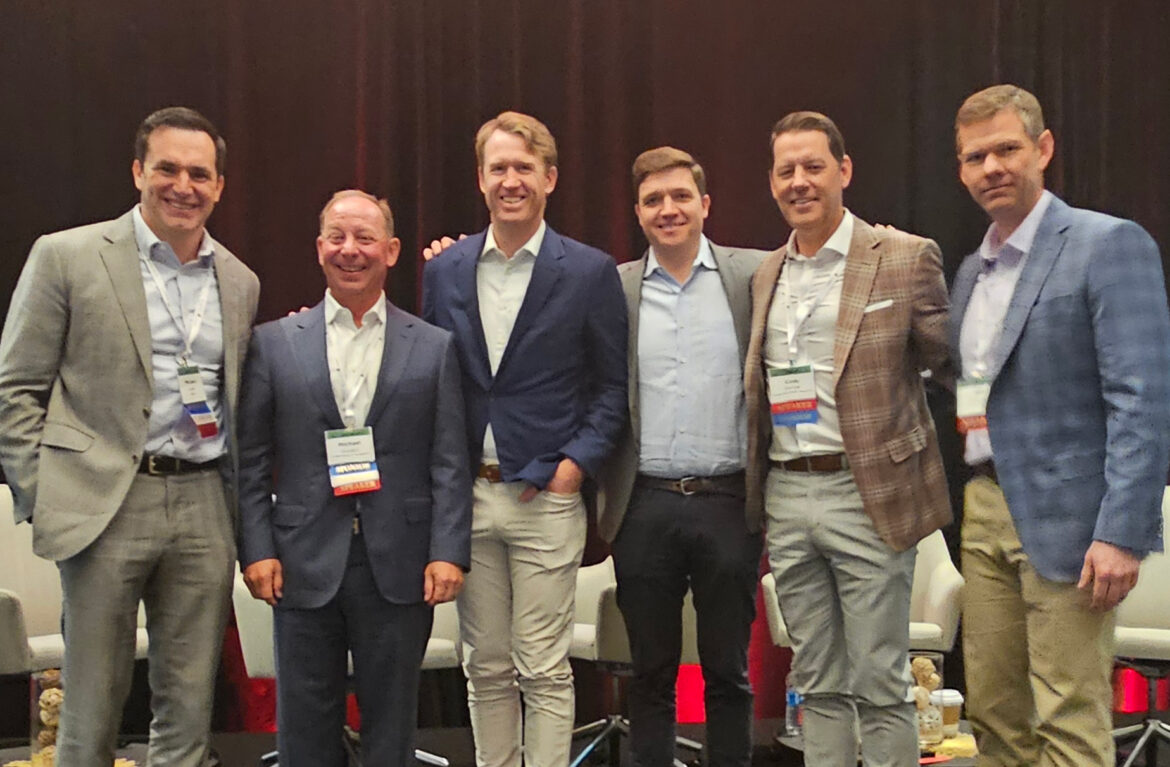DALLAS — The active adult subsector of seniors housing has officially emerged from its infancy as a commercial real estate market, but the specifics of the product type are still evolving as owners discover more and more about the incoming baby boomer residents.
That was the message from CEOs in the sector, who spoke on a CEO panel titled, “Where the Active Adult Space Is Now, and What Comes Next?” at InterFace Active Adult, held April 18 at The Westin Las Colinas in Dallas.
Panelists included Ben Burke, managing partner, Headwaters Group; Michael Uccellini, president and CEO, United Group of Cos.; Zach Crowe, managing director, U.S. real estate, Carlyle; Michael Levine, senior managing director, real estate, active adult, Greystar; and Jeff Patterson, co-founder and CEO, Sparrow Partners.
Cody Tremper, managing director of investment sales for seniors housing at Berkadia, moderated the discussion. He opened the panel by noting that the sector has “come a long way in the last 10 to 15 years.”
Uccellini, who is one of the trailblazers of active adult starting in the late 1990s, said that at that time active adult “was a product that nobody really knew.”
“The lenders didn’t know. The appraisers didn’t know. Back in the mid-2000s, the cap rate spread on active adult to multifamily was like 150 to 200 basis points [with lower cap rates for active adult]. We always had to explain to lenders and appraisers why we get a premium over multifamily.”
He went on to note that at least the commercial real estate industry now recognizes active adult as a standalone sector. There’s now a wealth of data from projects that have had a full life cycle — built, leased up, filled and sold — to help establish its differences from other types of housing.
“That data shows that we do get that 20 to 40 percent rent premium over Class A multifamily because of our lifestyle program and the age restriction. The data also shows that we trade at a cap rate that’s equal to and in some cases below MF. The lending and appraisal communities understand this now. We don’t have to go through this explanation.”
But now that it’s established, active adult is also changing as what he called the “Eisenhower-era generation” gives way to baby boomers, who have much different desires for their community. Uccellini estimates that baby boomers, the oldest of which turn 79 this year, make up 80 to 90 percent of active adult residents.
Levine noted that active adult went through some serious growing pains over its history. He notes that Greystar, now a giant in the industry, was at risk of failing in the mid-2010s, but recovered and now boasts $4.2 billion in active adult assets totaling nearly 21,000 units.
He said that in 2013 when he entered the industry, it was normal to have fewer than 10 prospective buyers investigate a property on the market. Today, he said that number can get up to 150 interested parties.
“Multifamily buyers thought, ‘These are older people, slip-and-fall risks, I don’t want to be in that market.’ Seniors housing buyers said, ‘How do I put a kitchen in and convert this to independent living and jack up the rents by $1,000?’ It’s exciting to see how far the market has come and the investor appreciation for this product type.”
Levine also encouraged the attendants at the conference — which has blossomed in its four years as the leading active adult conference in the nation — to “learn from the mistakes some of us made and hear us out.”
Defining today’s market
Tremper asked the panel where the market was headed in the next five to 10 years. The unfortunate truth, according to Crowe, is that each market — and even each submarket — is too different to make a blanket statement.
“It depends on the demographics and psychographics of that market. I would encourage everyone not to build the same product all over the country. People want different things. You really need to understand who your customer is.”
“There are so many different types of hotel flags and quality and service level,” continued Crowe. “Active adult isn’t too dissimilar from that. You have to think of it at a micro-market level.”
Burke added that the most successful communities are ones with “a campus style with various price points and offerings.”
“You’re going to hit different points on the demand curve and different income bands, so you’re never one product,” said Burke. “We want to make sure we’re providing a variety of units, a variety of unit sizes, locations, so we have a lot of offerings.”
The topic of variety bridged into a topic that was one the industry is still struggling with: build-to-rent cottages. Many of the properties offer cottage options for seniors who still want a single-family home, but no one on the panel had built a community exclusively of cottages with no accompanying apartments.
The reason isn’t demand. The panel universally agreed that cottages sell extremely well. The problem is the cost to build and the availability of land, building horizontally instead of vertically.
“They lease up the fastest, but they’re the most expensive to build,” noted Levine.
“In this environment in particular it’s tricky adding cottages to your otherwise high-density community. There’s demand for it for sure,” said Patterson. “From an economic standpoint, especially right now, it’s tough to absorb all that land. [Cottages] are pretty inefficient on the overall economics.”
He did predict that more build-to-rent, age-restricted, single-family homes will be on the horizon, though.
“There are people that are going to test it for us.”
— Jeff Shaw

